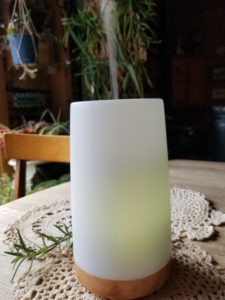Using a Diffuser
 Essential oils can be used topically on the skin or by breathing them in. Topical application is most effective for skin conditions, muscles and joints. When addressing goals for emotional, nervous system, cognitive, and respiratory system balance the most beneficial way to use essential oils is by inhalation. It is only necessary to dilute them with a carrier oil when using them in a personal scented oil to be used on the skin. For other methods of inhalation it is not necessary to dilute them.
Essential oils can be used topically on the skin or by breathing them in. Topical application is most effective for skin conditions, muscles and joints. When addressing goals for emotional, nervous system, cognitive, and respiratory system balance the most beneficial way to use essential oils is by inhalation. It is only necessary to dilute them with a carrier oil when using them in a personal scented oil to be used on the skin. For other methods of inhalation it is not necessary to dilute them.
Inhalation of essential oils utilizes the sense of smell to exert an influence on emotions, mood, concentration, sleep, memory, behavior and perception. Olfaction has the greatest impact on the regulation of these states of mind because the olfactory system has direct access to the limbic system which is the part of the brain responsible for them. When essential oil molecules are breathed into the nasal passages, receptors in the olfactory mucous membrane identify an odor. The sensory stimulation is transmitted through the olfactory bulb along the olfactory nerve, crossing the blood brain barrier, to engage the limbic system in the temporal lobe of the forebrain. Nerve impulses triggered in the limbic system affect other areas of the brain that are responsible for secreting hormones and regulating body functions. In addition respiration carries essential oil molecules to the lungs where they pass into the circulatory system. The entire process from initial inhalation to corresponding body responses takes place in a matter of seconds. A simple inhalation can cause instant changes in the body.
Application methods for inhalation include steam from a bowl or shower, diffusers, nebulizers, jewelry, personal inhalers and sprays. When using a room air diffuser 1 drop of essential oil to each 20 ml of water is a good ratio. It is also important to consider who will be in the room at the time the diffuser is running and choose essential oils accordingly. Small children including infants, frail or immune compromised individuals and pets require special considerations because there are essential oils that are contraindicated for certain populations. Cats should not be in a closed room with a diffuser going because they lack a specific liver enzyme that is necessary to metabolize essential oils.
Diffusers should not be used for hours at a time unless the concentration of essential oil in the water reservoir is so low that it is almost undetectable. An intermittent schedule of 30 to 60 minutes on and 30 to 60 minutes off will prevent over saturation of the olfactory system. Habituation to an aroma occurs after about 60 minutes anyway so diffusing longer than that is not helpful. Care should be taken to place a diffuser where the mist will not be directly breathed in but allows it to work in ambient air.
Diffuser jewelry, personal inhalers and sprays may be used as needed for a more targeted or personal application where using a diffuser would not be appropriate. Using a diffuser in public places, work spaces, doctors’ offices and classrooms without permission is not recommended. Certain scents are thought to be triggers for asthma, respiratory conditions, headaches and allergic reactions in some people.
